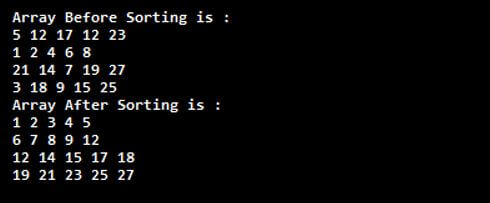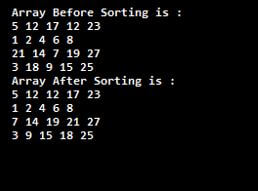2D Array Sorting in Java
The following article provides an outline for 2D Array Sorting in Java. An array of arrays can be a two-dimensional array. The matrices that make up the 2D array represent a collection of rows and columns. Because the elements of 2D arrays can get accessed at random, we can access the individual cells in a 2D array using their indexes, just like we can with one-dimensional arrays.
ADVERTISEMENT Popular Course in this category JAVA MASTERY - Specialization | 78 Course Series | 15 Mock TestsIn a 2D array, a cell has two indexes one is its row number, and the other is its column number. Sorting is a technique for arranging elements in a 2D array in a specific order. The 2D array can be in either ascending or descending order. Let’s see how to sort different ways the 2D array in Java in ascending and descending order.
Examples of 2D Array Sorting in Java
Different examples are as below:
Example #1
Example for 2D array sorting in Java to sort all elements of a 2D Array.
Code:
package jex;
import java.util.*;
public class demo {
// using bubble sort to sort 2D array
// sort 2D array same as it is in a 1D array of size n * m
public static void sort(int arr[][]) {
int i, j, temp;
int n=arr.length;
int m=arr[0].length;
for (i = 0; i < n * m - 1; ++i) {
for (j = 0; j < n * m - 1 - i; ++j) {
if (arr[j / m][j % m] > arr[(j + 1) / m][(j + 1) % m]) {
temp = arr[(j + 1) / m][(j + 1) % m];
arr[(j + 1) / m][(j + 1) % m] = arr[j / m][j % m];
arr[j / m][j % m] = temp;
}
}
}
}
public static void print(int arr[][]) {
int i, j;
int n=arr.length;
int m=arr[0].length;
for (i = 0; i < n; ++i) {
for (j = 0; j < m; ++j) {
System.out.print(arr[i][j]+" ");
}
System.out.println();
}
}
public static void main(String[] args)
{
Scanner sc=new Scanner(System.in);
int[][] arr={ { 5, 12, 17, 12, 23},
{ 1, 2, 4, 6, 8},
{21, 14, 7, 19, 27},
{ 3, 18, 9, 15, 25}
};
System.out.println("Array Before Sorting is : ");
print(arr);
sort(arr);
System.out.println("Array After Sorting is : ");
print(arr);
}
}Output:

As in the above program, the sort() method is useful to iterate each element of a 2D array, and when the current element is greater than the next element, then swap the numbers. Finally, the print method displays all the elements of the 2D array. In the main function, the 2D array is created and printed after and before calling the sort() function, as shown in the above output.
Example #2
Example for 2D array sorting in Java to sort all elements of a 2D array by column-wise.
Code:
package jex;
import java.util.*;
public class demo {
public static void sort(int arr[][]) {
int i, j,k, temp;
int n=arr.length;
int m=arr[0].length;
for (k = 0; k < m; ++k) {
for (i = 0; i < n; ++i) {
for (j = 0; j < n - 1 - i; ++j) {
if (arr[j][k] > arr[j + 1][k]) {
temp = arr[j + 1][k];
arr[j + 1][k] = arr[j][k];
arr[j][k] = temp;
}
}
}
}
}
public static void print(int arr[][]) {
int i, j;
int n=arr.length;
int m=arr[0].length;
for (i = 0; i < n; ++i) {
for (j = 0; j < m; ++j) {
System.out.print(arr[i][j]+" ");
}
System.out.println();
}
}
public static void main(String[] args)
{
Scanner sc=new Scanner(System.in);
int[][] arr={ { 5, 12, 17, 12, 23},
{ 1, 2, 4, 6, 8},
{21, 14, 7, 19, 27},
{ 3, 18, 9, 15, 25}
};
System.out.println("Array Before Sorting is : ");
print(arr);
sort(arr);
System.out.println("Array After Sorting is : ");
print(arr);
}
}Output:

As in the above rewrite program, the sort() method is useful to iterate each element of a 2D array and sort the array column-wise. Finally, the print method displays all the elements of the 2D array. In the main function, the 2D array is created and printed after and before calling the sort() function, as shown in the above output.
Example #3
To sort all elements of a 2D array by row-wise.
Code:
package jex;
import java.util.*;
public class demo {
// using bubble sort to sort 2D array
// sort 2D array same as it is in a 1D array of size n * m
public static void sort(int arr[][]) {
int i, j,k, temp;
int n=arr.length;
int m=arr[0].length;
for(k=0;k<n;++k){
// applying bubble sort on kth row
for(i=0;i<m;++i){
for(j=0;j<m-1-i;++j){
if(arr[k][j]>arr[k][j+1]){
temp = arr[k][j+1];
arr[k][j+1] = arr[k][j];
arr[k][j] = temp;
}
}
}
}
}
public static void print(int arr[][]) {
int i, j;
int n=arr.length;
int m=arr[0].length;
for (i = 0; i < n; ++i) {
for (j = 0; j < m; ++j) {
System.out.print(arr[i][j]+" ");
}
System.out.println();
}
}
public static void main(String[] args)
{
Scanner sc=new Scanner(System.in);
int[][] arr={ { 5, 12, 17, 12, 23},
{ 1, 2, 4, 6, 8},
{21, 14, 7, 19, 27},
{ 3, 18, 9, 15, 25}
};
System.out.println("Array Before Sorting is : ");
print(arr);
sort(arr);
System.out.println("Array After Sorting is : ");
print(arr);
}
}Output:

As in the above rewrite program, the sort() method is useful to iterate each element of a 2D array and sort the array row-wise. Finally, the print method displays all the elements of the 2D array. In the main function, the 2D array is created and printed after and before calling the sort() function, as shown in the above output.
Conclusion
Sorting is a technique for arranging elements in a 2D array in a specific order. For example, in a 2D array, a cell has two indexes: its row number and its column number.
The above is the detailed content of 2D Array Sorting in Java. For more information, please follow other related articles on the PHP Chinese website!

Hot AI Tools

Undresser.AI Undress
AI-powered app for creating realistic nude photos

AI Clothes Remover
Online AI tool for removing clothes from photos.

Undress AI Tool
Undress images for free

Clothoff.io
AI clothes remover

Video Face Swap
Swap faces in any video effortlessly with our completely free AI face swap tool!

Hot Article

Hot Tools

Notepad++7.3.1
Easy-to-use and free code editor

SublimeText3 Chinese version
Chinese version, very easy to use

Zend Studio 13.0.1
Powerful PHP integrated development environment

Dreamweaver CS6
Visual web development tools

SublimeText3 Mac version
God-level code editing software (SublimeText3)

Hot Topics
 Break or return from Java 8 stream forEach?
Feb 07, 2025 pm 12:09 PM
Break or return from Java 8 stream forEach?
Feb 07, 2025 pm 12:09 PM
Java 8 introduces the Stream API, providing a powerful and expressive way to process data collections. However, a common question when using Stream is: How to break or return from a forEach operation? Traditional loops allow for early interruption or return, but Stream's forEach method does not directly support this method. This article will explain the reasons and explore alternative methods for implementing premature termination in Stream processing systems. Further reading: Java Stream API improvements Understand Stream forEach The forEach method is a terminal operation that performs one operation on each element in the Stream. Its design intention is
 PHP: A Key Language for Web Development
Apr 13, 2025 am 12:08 AM
PHP: A Key Language for Web Development
Apr 13, 2025 am 12:08 AM
PHP is a scripting language widely used on the server side, especially suitable for web development. 1.PHP can embed HTML, process HTTP requests and responses, and supports a variety of databases. 2.PHP is used to generate dynamic web content, process form data, access databases, etc., with strong community support and open source resources. 3. PHP is an interpreted language, and the execution process includes lexical analysis, grammatical analysis, compilation and execution. 4.PHP can be combined with MySQL for advanced applications such as user registration systems. 5. When debugging PHP, you can use functions such as error_reporting() and var_dump(). 6. Optimize PHP code to use caching mechanisms, optimize database queries and use built-in functions. 7
 PHP vs. Python: Understanding the Differences
Apr 11, 2025 am 12:15 AM
PHP vs. Python: Understanding the Differences
Apr 11, 2025 am 12:15 AM
PHP and Python each have their own advantages, and the choice should be based on project requirements. 1.PHP is suitable for web development, with simple syntax and high execution efficiency. 2. Python is suitable for data science and machine learning, with concise syntax and rich libraries.
 PHP vs. Other Languages: A Comparison
Apr 13, 2025 am 12:19 AM
PHP vs. Other Languages: A Comparison
Apr 13, 2025 am 12:19 AM
PHP is suitable for web development, especially in rapid development and processing dynamic content, but is not good at data science and enterprise-level applications. Compared with Python, PHP has more advantages in web development, but is not as good as Python in the field of data science; compared with Java, PHP performs worse in enterprise-level applications, but is more flexible in web development; compared with JavaScript, PHP is more concise in back-end development, but is not as good as JavaScript in front-end development.
 PHP vs. Python: Core Features and Functionality
Apr 13, 2025 am 12:16 AM
PHP vs. Python: Core Features and Functionality
Apr 13, 2025 am 12:16 AM
PHP and Python each have their own advantages and are suitable for different scenarios. 1.PHP is suitable for web development and provides built-in web servers and rich function libraries. 2. Python is suitable for data science and machine learning, with concise syntax and a powerful standard library. When choosing, it should be decided based on project requirements.
 Java Program to Find the Volume of Capsule
Feb 07, 2025 am 11:37 AM
Java Program to Find the Volume of Capsule
Feb 07, 2025 am 11:37 AM
Capsules are three-dimensional geometric figures, composed of a cylinder and a hemisphere at both ends. The volume of the capsule can be calculated by adding the volume of the cylinder and the volume of the hemisphere at both ends. This tutorial will discuss how to calculate the volume of a given capsule in Java using different methods. Capsule volume formula The formula for capsule volume is as follows: Capsule volume = Cylindrical volume Volume Two hemisphere volume in, r: The radius of the hemisphere. h: The height of the cylinder (excluding the hemisphere). Example 1 enter Radius = 5 units Height = 10 units Output Volume = 1570.8 cubic units explain Calculate volume using formula: Volume = π × r2 × h (4
 PHP: The Foundation of Many Websites
Apr 13, 2025 am 12:07 AM
PHP: The Foundation of Many Websites
Apr 13, 2025 am 12:07 AM
The reasons why PHP is the preferred technology stack for many websites include its ease of use, strong community support, and widespread use. 1) Easy to learn and use, suitable for beginners. 2) Have a huge developer community and rich resources. 3) Widely used in WordPress, Drupal and other platforms. 4) Integrate tightly with web servers to simplify development deployment.
 PHP's Impact: Web Development and Beyond
Apr 18, 2025 am 12:10 AM
PHP's Impact: Web Development and Beyond
Apr 18, 2025 am 12:10 AM
PHPhassignificantlyimpactedwebdevelopmentandextendsbeyondit.1)ItpowersmajorplatformslikeWordPressandexcelsindatabaseinteractions.2)PHP'sadaptabilityallowsittoscaleforlargeapplicationsusingframeworkslikeLaravel.3)Beyondweb,PHPisusedincommand-linescrip






